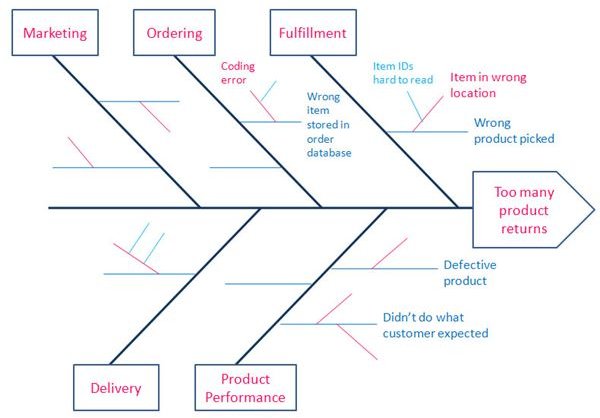Fishbone vs. Apollo Root Cause Analysis for Six Sigma and Agile
About Root Cause Analysis
In Six Sigma and other quality management initiatives, identifying the root causes of a problem and implementing solutions that counter those root causes are critical for project success. Several tools are available to help project teams brainstorm, organize and evaluate potential root causes.
Some are less structured, such as the “5 Whys” method, which simply requires asking “why?” in a repetitive fashion to determine why a problem is occurring to get at deeper levels of causation. Others, such as fish bone or Ishikawa diagrams and Apollo Root Cause Analysis (ARCA) provide a structured tool to aid organization and evaluation of potential root causes.
Both of these tools represent an overall methodology that includes properly defining the problem, identifying potential root causes, confirming true root causes, and implementing solutions that counter those root causes. Both the fish bone diagram and the Apollo cause-and-effect chart (also known as a Realitychart) provide a visual means of organizing cause and effect data for analysis.
Using Fishbone vs. Apollo Root Cause Analysis
Fishbone Diagrams (Ishikawa Diagrams)
Green Belt and Black Belt students typically learn about fish bone diagrams as a tool for uncovering root causes during the Analyze phase of a DMAIC project. Created by Kaoru Ishikawa in the 1960s, the fish bone diagram is considered one of seven basic quality control tools, along with other Six Sigma standards such as the control chart and Pareto chart.
The Ishikawa diagram gets the nickname “fish bone diagram” from its appearance. In the head of the fish is the statement of the problem for which root causes are sought. The main bones typically represent categories of causes. For instance, in the manufacturing sector, root causes are often categorized into “the 4 Ms”: Machine, Method, Material, and Manpower. Other industries, or even some manufacturing companies or project leaders, may use categories such as People, Process, Environment, Equipment, and Supplies.
The next level bones drawn off of those main bones represent the first level of answers to the question, “Why might this problem be occurring?” For each of those potential causes, the question “why?” is asked again, and any answers are incorporated as smaller bones coming off of that one. For a complex problem, the fish can have many levels of bones. In that case it can be helpful to color code the diagram as in the example shown here.
Once the fish bone diagram is complete, project leaders use a variety of techniques to evaluate the potential root causes that were brainstormed and confirm which do in fact affect the outcome, typically a measure of process performance. In some cases simple investigation is sufficient, in other cases experimentation may be required to confirm a cause-and-effect relationship between a proposed root cause and the problem under study.
Apollo Root Cause Analysis (ARCA)
ARCA is the brainchild of Dean Gano, who studied a variety of root cause analysis tools and methodologies and identified what he considered to be weaknesses in all of them. According to Gano, people often do not achieve real success with root cause analysis because they stop too soon (before reaching the real root cause), focus on placing blame, or fall victim to what he calls “the root cause myth.”
He claims it is a fallacy to believe that there is one root cause for a given problem, and stresses that identification of a single root cause can only be accomplished in conjunction with selecting the type of solution for the problem. For example, the cause of a fire typically has several components, and depending on the situation only one of those may be identified as a root cause that must be or can be addressed.
Gano also feels that trying to categorize potential root causes is unhelpful, and can actually hinder project teams in their efforts to uncover true root causes and viable solutions. So his method of root cause analysis does not have a categorization component as does the fish bone method.
Rather, Apollo Root Cause Analysis focuses on identifying both conditions and actions that can lead to the problem outcome, and documenting evidence to confirm or deny each of them. This methodology takes into account the fact that a condition alone typically does not represent a cause, without the corresponding action that results from that condition and leads to the problem. Similarly, the action alone does not cause the problem unless the condition is also present. Ideally, improvement efforts should focus on eliminating the condition so that the related action never becomes a factor.
<em>Learn more about Apollo Root Cause Analysis and see an example</em>.
The RealityCharting software program can help project teams implement the Apollo Root Cause Analysis method, walking them through steps such as defining the problem, identifying potential causes, and documenting evidence.
